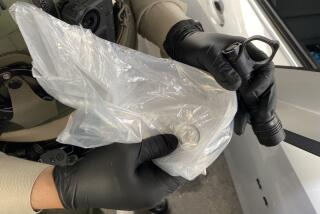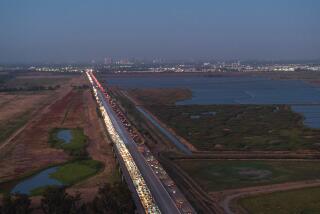Reading Between the Lines
- Share via
NORTH HOLLYWOOD — To robbery, burglary and murder scenes they lug kits containing two types of dust and a small brush.
Meticulously, partners Ron Troncone and Ray Wicks stroke charcoal-like magnetized powder on walls, cabinets, desks or anything they think the suspect may have touched. Donning a single soiled white glove, using a series of long vertical and short horizontal strokes, each man “scans” with his brush, looking for the slightest trace of a print. When they find one, they use transparent tape to transfer it onto a small piece of cardboard paper.
The task of lifting an invisible oil-and-amino acid-based impression--better known as a fingerprint--from a crime scene and positively tying it to a suspect has become practically an art form for these two veteran Los Angeles police detectives.
Troncone, 49, and Wicks, 50, have been plying their craft full time since 1987 when, because of their reputation as the department’s best fingerprinting patrol officers, they were called upon by former LAPD Chief Daryl F. Gates to set up a fingerprinting unit. Until then, fingerprinting had been handled by regular patrol officers with little or no formal training in the complicated procedure. More times than not, Troncone said, officers would ruin prints crucial to investigations.
Since the implementation of the unit, the pair have set the standard for the department while training officers at 17 other LAPD divisions.
Last year, according to department statistics, their work at the North Hollywood Division was directly responsible for 280 felony arrests, making that division the city’s leader for the sixth consecutive year in positive identification of suspects through fingerprints, and helping make LAPD the leader in the nation.
Their prowess in the field is widely recognized. Several of their procedures, in fact, are documented in the International Fingerprinting Society magazine, based in Scotland Yard.
Both men modestly attribute their success to the amount of time they have spent on the force as patrol officers.
Troncone worked 18 years as a North Hollywood Division patrol officer before being selected along with Wicks--who was a North Hollywood patrol officer for 17 years--to design the Area Latent Print unit, also known as ALPO.
The biggest advantage of experience, according to Troncone, is that he and his partner can mentally restructure a crime as it occurred, predicting where suspects touched things and dusting in those places.
On a recent outing involving a warehouse break-in where the perpetrator climbed down through a hole in an office roof and stole money, they tossed the magic dust along a hypothetical path, uncovering a series of prints the burglar made on the wall when dropping himself through the hole.
Even though they have examined thousands of fingerprints, the two men still are enthusiastic when they find a good one. They discuss a print in terms such as “deltas,” “loops,” and “whirls,” to describe the pattern of “friction ridges,” or the lines that make up a print and make it unique.
“When we go to a scene, we have the attitude that the suspect is still there, in a sense,” Troncone said. “Our job is to reveal him.”
When they go out to lift prints from a home or car, the officers also put themselves in the victim’s position and try to advise him or her on how to avoid future problems.
“When we go out to a crime scene, in addition to doing our job, we try to steer the victim in the right direction to prevent the crime from happening again,” Wicks said.
The most notable case cracked by the pair came during investigation of a routine vandalism incident where a man was arrested for using his bare hands to break a window at a residence. After he was arrested, the two took prints from a piece of glass the man broke and entered them in the department’s new computer, which contains print records from every convicted felon and unsolved crime in Los Angeles County. The computer also has a national linkup enabling it to access millions of prints throughout the country.
What came back shocked Troncone and Wicks.
In eight previous months, Troncone and Wicks had gone out to about 140 different burglary scenes where they had lifted the same fingerprint. They repeatedly entered the print in the computer, but the suspect’s name was not on file and police were unable to make an identification.
But when the vandal’s prints were entered into the computer after he was arrested, they finally were matched to the burglaries and he was charged with all 140 counts.
Fingerprinting is starting to become more science than art, with new procedures such as one in which a special spray is emitted throughout a crime scene, enabling an officer to view all fingerprints through special lenses.
However, the equipment and process is costly and takes time, which means it can be used only sparingly and at major crime scenes. Once an area has been sprayed, it takes 24 hours for the toxic, acid-based spray to illuminate a print.
Right now at least, that’s no competition for Troncone and Wicks.
More to Read
Sign up for Essential California
The most important California stories and recommendations in your inbox every morning.
You may occasionally receive promotional content from the Los Angeles Times.













